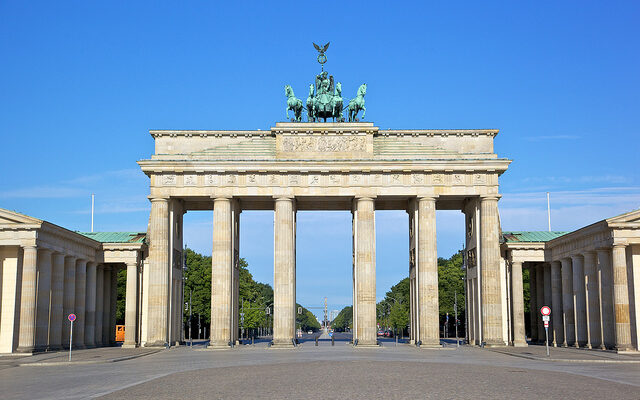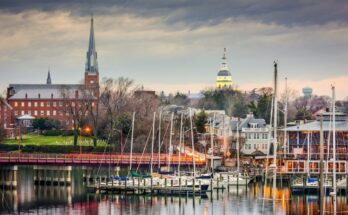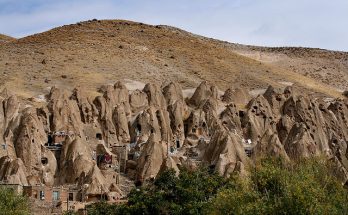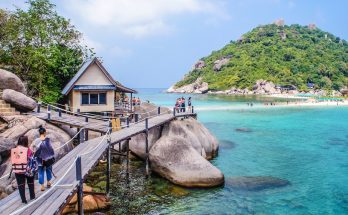The capital city of Germany is rich with history and culture. Badly fractured during World War II and the cold war, Berlin has recreated itself into an international city with diverse cultures and architecture. Explore the top tourist attraction in Berlin that still bears the scars of the recent past.
Map of Berlin
25. Oberbaum Bridge
The Oberbaumbrücke, or Oberbaum Bridge, spans the Spree River. The bridge is two stories high, and it links the districts of Friedrichshain and Kreuzberg. It ties together the former East Germany with the West, making it a historically significant as well as architecturally beautiful structure.
The Oberbaum Bridge is one of the most photographed landmarks in the whole city. It’s a sign of unity, a way to bridge the east and the west in the once divided Berlin. You can cross the bridge on foot, but the best views are further along the Spree from either side of the river.
24. German Historical Museum
 © Elxeneize / Dreamstime
© Elxeneize / DreamstimeThe German Historical Museum, also known as the Deutsches Historisches Museum, is a fantastic place to visit if you want to see what Germans have been up to for the past two millennia. The museum covers all of German history up until the present day, and exhibits are laid out in a way that is easy to understand and highly entertaining.
The museum is housed in two adjacent buildings: The more traditional Armory, or Zeughaus, and the modern Exhibition Ball designed by I.M. Pei. You can browse through posters from World War II, see maps from the 19th century or admire contemporary sculpture done by modern German artists.
23. Kurfurstendamm
Kurfürstendamm, known to locals at Ku’damm, was built as a German answer to the Champs-Elysee in Paris. The wide road was lined with trees and ornate buildings were built along both sides. It is the heart of former West Berlin, and is still the city’s most popular shopping boulevard.
The side streets of Tauentzienstraße and Fasanenstraße are lined with malls and high-end flagship stores. If you’re in the area, be sure to check out KaDeWe, or the Kaufhaus des Westens. This is the largest department store in all of Europe, and it boasts virtually anything you might want to purchase from expensive shoes to fresh produce.
22. Berlin TV Tower

Located near the Alexanderplatz is the Berlin TV Tower, better known to locals at the Berliner Fernsehturm. This tower is the tallest structure in all of Germany, and its observation deck offers an incredible vantage point for amazing views over much of the city.
The Berlin TV Tower was built in the 1960s, and it is one of the most significant mid-century modern buildings in Germany. At the time of its construction, it was also a true engineering marvel. Just below the main observation deck, there is an upscale restaurant where you can enjoy the view with a drink or a full meal.
21. DDR Museum

The DDR Museum is appropriately located in the heart of the former government district of East Germany, and it is devoted to the history of the DDR, or the Deutsche Demokratische Republik.
When you visit, you can see what life was like in former East Germany. See the apartments people lived in, put on some of the most common clothing items from the period and check out the covert listening devices, or bugs, used to spy on citizens. Exhibits are in English as well as German.
20. Treptower Park
 © Sergey Kohl / Dreamstime
© Sergey Kohl / DreamstimeAlongside the river Spree, south of central Berlin, you’ll find Treptower Park. If you’re interested in WW2 history, then the park is a must-see destination in Berlin. The park is home to a large military cemetery as well as the enormous Soviet War Memorial that was built in 1949 to commemorate the Soviet soldiers who fell in the Battle of Berlin.
There are a number of plates set around the park, each of which memorializes certain battles. Beyond the historical significance, Treptower Park is an awesome place to walk along the paved pedestrian pathways, rent a rowboat for some time on the water or just have a drink in the park’s biergarten.
19. Berlin Wall Memorial
 © Hanohiki / Dreamstime
© Hanohiki / DreamstimeThere are many different ways to see the Berlin Wall while in the city. If places like Checkpoint Charlie feel too touristy, head to the Berlin Wall Memorial, known in German as the Gedenkstätte Berliner Mauer. It’s a memorial to the countless men, women and children who died while trying to get across the wall.
There is also an adjacent documentation center on Bernauer Straße with additional exhibits and information, although much of it is in German. From the viewing platform, you can see what once was the no-man’s land between East and West Berlin.
18. Unter den Linden

This beautiful boulevard lined with linden trees is one of the main east-west routes through Berlin. The trees were first planted in the mid 1600s and are cared for and cultivated by the city. Over the centuries the boulevard has been extended and now stretches from Museum Island to the Brandenburg Gate.
Greatly damaged during the war, Unter den Linden has been renovated and is currently lined with many architectural sites and other tourist attractions in Berlin including the German Historical Museum, the Staatsoper, Altes Palais and the Palace Bridge.
17. Berlin Cathedral
 © Jan Kranendonk / Dreamstime
© Jan Kranendonk / DreamstimeThere are many wonderful churches to see in Berlin, but the Berlin Cathedral is the largest and one of the most impressive. It was built at the start of the 20th century as a way to express the imperial power of Germany. The brick, neo-Renaissance cathedral is located in the area of Museum Island in the district of Mitte.
The enormous organ is a major point of pride in the cathedral, and it is still used for religious services. If you visit, you can climb to the top of the dome and enjoy views from the cathedral after touring the interior.
16. Alexanderplatz
 © Petarneychev / Dreamstime
© Petarneychev / DreamstimeIf you visit Berlin, you’ll almost certainly spend some time in Alexanderplatz. This large public square is right in the heart of the Mitte district, and it is the major hub for transport in Berlin. Today, it is also home to some of the most popular historic attractions in the city.
From the Alexanderplatz, you can see the Berlin TV Tower dominating the skyline, the World Clock and the Neptune Fountain. There are also plenty of local shops, restaurants and even a casino. The plaza is also home to the Galeria Kaufhof, one of the busiest shopping spots in the area.
15. Charlottenburg Palace
 © Wojciech Sleczek / Dreamstime
© Wojciech Sleczek / DreamstimeIf you like touring palaces, then don’t miss the Charlottenburg Palace. This is the largest palace in Germany, and it is found in Berlin’s City West district. Charlottenburg Palace was constructed at the end of the 17th century, and the entire community of Charlottenburg grew around it.
Built in the Baroque style, and boasting beautiful gardens and outdoor sculptures, the palace is now open to the public. You can tour restored rooms and see the extravagant, rococo style in the apartments of Frederick the Great, and you can also see collections of porcelain, crown jewels and royal silver.
14. Victory Column
 © Patryk Kosmider / Dreamstime
© Patryk Kosmider / DreamstimeThe Siegessäule, or Victory Column, was built toward the end of the 19th century in celebration of several Prussian military triumphs. The column originally stood in front of the Reichstag but was moved to the middle of Tiergarten by the Nazi government as part of a major urban redevelopment plan.
At the very top of the column is an angelic, winged figure that represents Victoria, the Roman goddess of victory. At the top of the Victory Column is an observation deck that allows for panoramic views over the city. There’s just one catch: There is no elevator. If you’re feeling up for it, take on the 285 steps to get to the top.
13. Gendarmenmarkt

The Gendarmenmarkt is a major public square in Berlin that dates all the way back to the 17th century. Although many of the historic buildings in the Gendarmenmarkt were destroyed in World War II, several major landmarks remain.
With a visit to the Gendarmenmarkt, you’ll be able to see the Deutscher Dom and the Französischer Dom, or French Cathedral, which was built by the Huguenots in the early 18th century. The Gendarmenmarkt is also home to the beautifully reconstructed Konzerthaus, where the Berlin Orchestra performs. During the winter, Christmas markets are a major highlight at the square.
12. Topography of Terror
 © Williammacgregor / Dreamstime
© Williammacgregor / DreamstimeOne of the more poignant attractions in Berlin is the Topography of Terror. This is an indoor and outdoor museum located on the exact site of the former Nazi government’s SS Reich Main Security Office.
Within view of the Berlin Wall, former prisons cells were excavated to showcase the tragedies and horrors of the Nazi regime. Exhibits explore the Jewish ghettos of Berlin, the criminals brought to justice at the Nuremberg Trials and a memorial to all those who perished at the hands of the Nazis. It can be emotionally tough to explore the Topography of Terror, but it an important historical stop to make.
11. Pergamon Museum
 © Vvoevale / Dreamstime
© Vvoevale / DreamstimeIn Berlin’s Museum Insel you’ll find the fascinating Pergamon Museum. The whole museum is named for the Pergamon Altar, which is one of its most valued attractions on display. The Pergamon Museum is the most visited art museum in Germany, and it boasts an incredible collection of antiquities and treasures.
Touring the museum is a way to bring the ancient world to life. Some of the most notable attractions in the Pergamon include the Ishtar Gate of Babylon, the Mschatta Façade from a desert castle in Jordan and the Roman Market Gate of Miletus, which dates back to the 2nd century.
10. Hackesche Hoefe
 © Tupungato / Dreamstime
© Tupungato / DreamstimeLocated at the far end of Oranienburger Strasse in the Scheunenviertel, the Hackesche Höfe is a complex that includes eight interconnected courtyards. It was designed and built by the architect Kurt Berndt, and the Art Nouveau façade was the work of August Endell.
As with many Berlin courtyard buildings, the complex was used for a mixture of offices, shops and flats. The buildings were only partially damaged during the WW2, but were mostly neglected while Germany was partitioned. Only after reunification, starting in 1993, was the complex extensively restored and it now looks better than it ever has.
Inside the Höfe you’ll find a wide variety of cafes, restaurants and shops that attract tons of locals and visitors each day. As you travel from one courtyard to the next to see more vendors, you’ll understand the unique nature of this complex.
9. Tiergarten
Once the hunting grounds of the Brandenburg elite, the Großer Tiergarten is now an urban park in central Berlin. Commemorating a Prussian victory, the Berlin Victory Column stands in the park and is surrounded by a street circle.
Pedestrians can reach the column by using any of four underground tunnels. Near the Column sits Schloss Bellevue, the Beautiful Palace, which is the official residence of the President of Germany.
Occupying the southwest corner of the Tiergarten, the Berlin Zoo houses around 14,000 animals. The open-air habitats have made it one of the most popular zoos in Europe.
8. Check Point Charlie
One of the best known crossing points of the Berlin Wall, Checkpoint Charlie resonates with emotional and historical significance. Named by the Western Allies, the border crossing bore an ominous sign stating “You are leaving the American Sector”.
This was the single crossing point for members of the Allied forces and foreigners. The guardhouse which once stood here is now on display at the Allied Museum in Berlin-Zehlendorf.
A replica of a U.S. Army guardhouse stands at the crossing, and cobblestones are used to designate the former border spot. The best documentation on escape attempts and the original Checkpoint sign can be found in the museum Haus am Checkpoint Charlie.
7. Potsdamer Platz

Art, entertainment and shopping can all be found in this vibrant corner of Berlin. The square was completely destroyed after the war but has been rebuilt into a modern plaza with landmark towers and a shopping arcade.
The area is seen as symbolic reconnection of the two halves of Berlin, joining the residents of both sides in a completely new part of the city. A replica of Germany’s first traffic light stands in the center with sleek, modern office buildings surrounding the platz.
The DaimlerChrysler Atrium offers a changing art exhibit while the Sony Centre features a Cinema Complex and Film Museum, a shopping mall and a 3D IMAX theater.
6. Memorial Church

The Kaiser Wilhelm Memorial Church is in the center of the Breitscheidplatz in Berlin. The original church was built between 1891 and 1895 by Kaiser Wilhelm II. During WWII the church burned down after it was hit by an allied bomb, only the broken west tower of the church was still standing.
In 1961 a new church, consisting of 4 buildings, was constructed around the remains of the old church. The concrete and glass structure is a fascinating counterpoint to the neo-Romanesque old church that it surrounds. Photos of the original church can be found in the remaining west tower along with some of the original mosaics.
5. Museum Island
Five museums comprise Museum Island which is located between the Spree River and Kupfergraben. As with many of the structures in Berlin, the old museum buildings were nearly destroyed during the Second World War but are now open.
The Altes Museum displays ancient Greek and Roman artifacts, while the Alte Nationalgalerie houses the largest collection of 19th century paintings and sculptures in Germany. The Nues Museum houses prehistoric pieces and Egyptian art, including the bust of Queen Nefertiti.
The Pergamon Museum contains another display of Greek and Babylonian antiquities. The Ishtar Gate and Pergamon Altar are here. Finally, the Bode Museum displays a large collection of sculptures, numismatic (coin) collections and a number of paintings.
4. East Side Gallery

The East Side Gallery is the longest stretch of the Berlin Wall still in existence. Often described as a memorial to freedom, it showcases paintings of artists from around the world.
The artwork, which began appearing in 1990, documents the changing time after the fall of the Berlin Wall as well as expressing hope for the future. Sections of the wall have been moved to facilitate construction and other portions have been damaged by erosion and vandalism.
3. Holocaust Memorial
Near the Brandenburg Gate, the Holocaust Memorial is a simple, but powerful tribute to the Jews that died as a result of Hitler’s extermination plan. The 2,711 slabs are arranged in a wave-like pattern over 205,000 square feet.
Each stone is unique, varying from ankle high to over six feet tall. The paths between the slabs undulate with the overall effect being one of instability and disorientation.
There is no set pattern and visitors may walk in any direction through the peaceful, quiet stones. At the base of the memorial an underground information center offers information and personal stories of people affected by the actions of the Nazi party.
2. Reichstag

The Reichstag is the seat of the German Parliament and an historic landmark. A fire in 1933 and air raids during the Battle of Berlin in 1945 caused a great deal of damage.
The Reichstag sits near the Brandenburg Gate and was not fully restored until after the deconstruction of the Berlin Wall and the German reunification. Some historical scars, such as graffiti left by Soviet soldiers, were left as a tribute to the building’s difficult past.
The original building was designed by several architects and the mix of styles in the completed structure was somewhat controversial at the time, but now is appreciated by thousands of visitors each year. The glass dome at the top of the building provides a magnificent view of the city and visitors must register in advance to enter it.
1. Brandenburg Gate

Built in the late 1700s, the Brandenburg gate is the only surviving city gate of Berlin. The gate is in the western part of Berlin and marks the entrance to Unter den Linden. Used as one of the Berlin Wall crossings, the gate became a site of protest during the division of Germany and a place of celebration when the wall fell in 1989.
The gate was severely damaged in World War II and underwent extensive renovation in the early 2000s. Today it is fully restored and is the symbol of not only the turbulent history of the region, but also the reunification of East and West Berlin.



